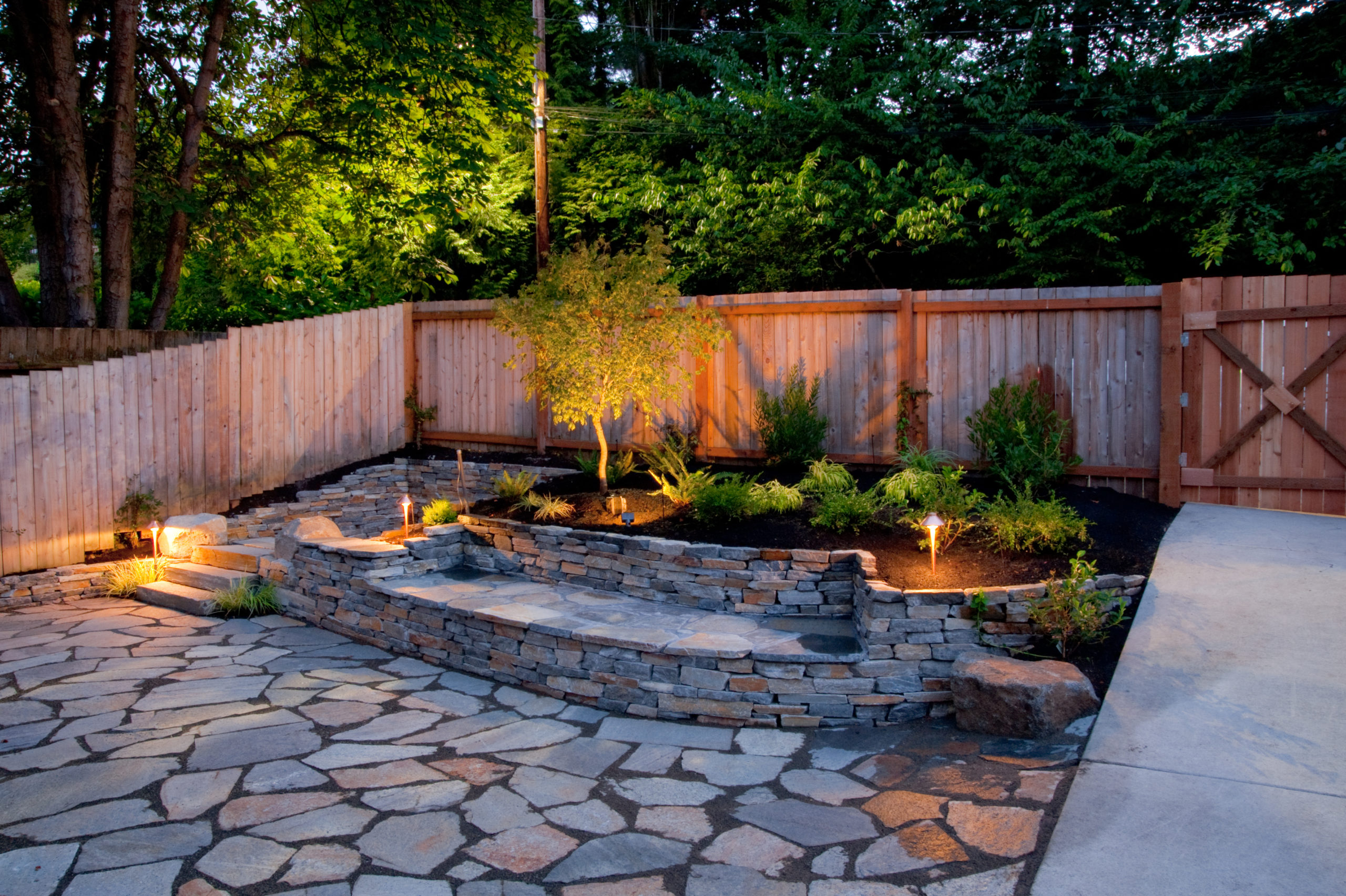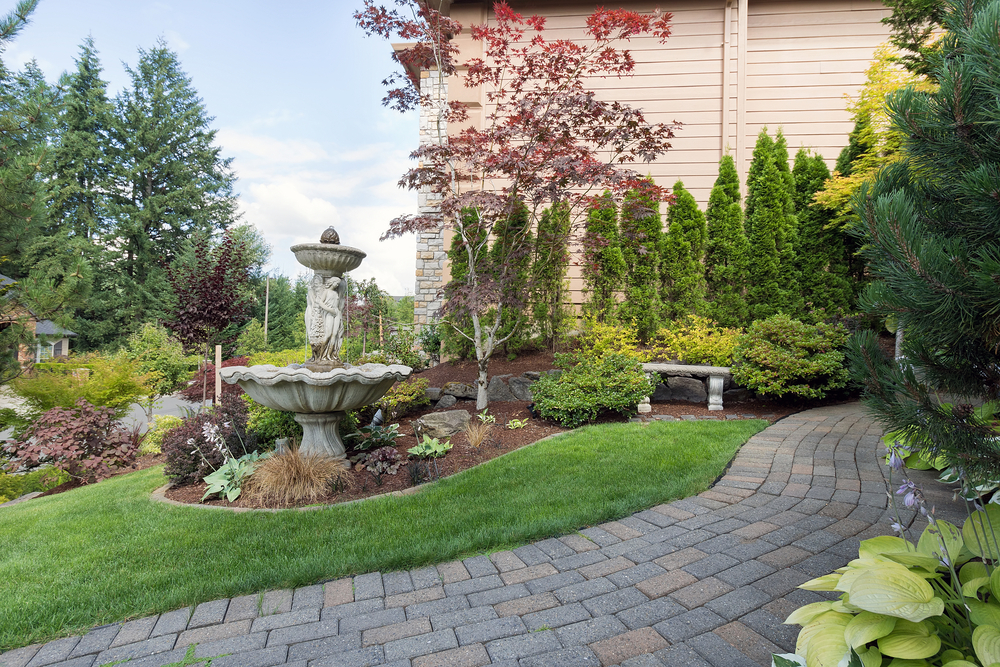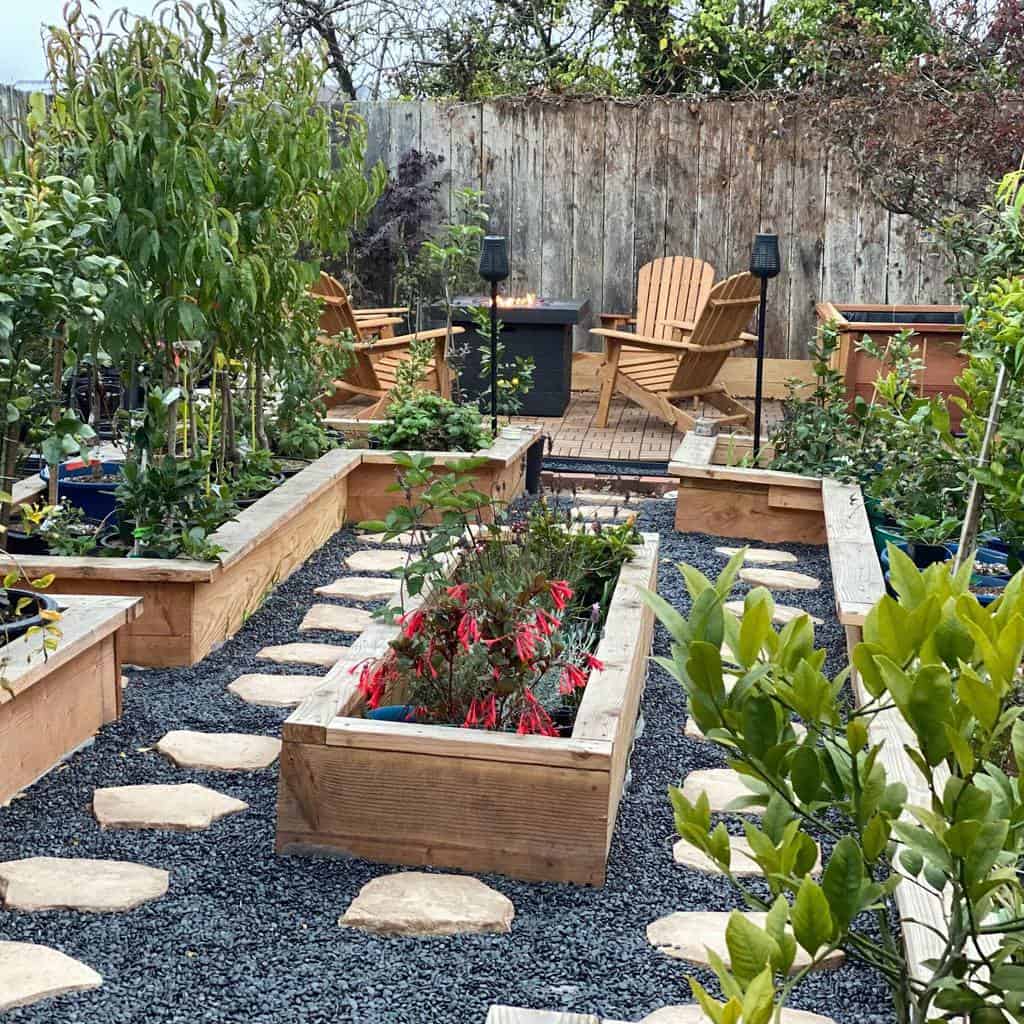Pathways and Walkways

Pathways and walkways are essential elements of garden design, providing access, guiding visitors, and enhancing the overall aesthetic appeal. They act as a framework for the garden, connecting different areas and leading the eye towards focal points.
Types of Pathways and Walkways
Pathways and walkways come in various styles, each offering distinct advantages and considerations.
- Straight Pathways: Straight pathways provide a direct route and create a sense of order and formality. They are well-suited for smaller gardens or areas with limited space.
- Curved Pathways: Curved pathways add a sense of whimsy and movement to the garden. They can create a more intimate feel and encourage exploration.
- Winding Pathways: Winding pathways are designed to meander through the garden, creating a sense of discovery and intrigue. They are best suited for larger gardens where they can showcase different plant groupings and features.
- Looping Pathways: Looping pathways lead visitors on a circular journey, allowing them to experience different aspects of the garden from various perspectives. They are often used to create a sense of enclosure and intimacy.
Materials for Pathways, Using hardscaping to enhance garden design
Choosing the right materials for pathways is crucial, considering factors such as durability, cost, and aesthetics.
- Stone: Stone is a durable and long-lasting material that can withstand heavy foot traffic. It comes in a wide variety of colors, textures, and sizes, offering versatility in design. Popular choices include flagstone, slate, and granite.
- Gravel: Gravel is a cost-effective and low-maintenance option. It provides a natural and rustic look, complementing informal gardens. However, gravel can be difficult to walk on in wet weather.
- Brick: Brick offers a classic and timeless look, adding a touch of elegance to the garden. It is durable and can be arranged in various patterns to create visual interest.
- Wood: Wood is a warm and natural material that blends well with surrounding vegetation. However, it requires regular maintenance to prevent rotting and decay.
- Concrete: Concrete is a strong and durable material that can be molded into various shapes and patterns. It is often used for pathways in modern or contemporary gardens.
Designing a Winding Pathway
A winding pathway can be a captivating element in a garden, adding a sense of adventure and leading visitors on a journey of discovery. Here are some key considerations:
- Follow the Garden's Flow: The pathway should flow naturally through the garden, weaving around trees, plants, and other features.
- Lead to Focal Points: The pathway should lead to key areas of interest, such as a pond, sculpture, or seating area.
- Create a Sense of Discovery: The pathway should be designed to reveal different aspects of the garden as visitors progress.
- Consider the Scale: The width of the pathway should be appropriate for the size of the garden and the intended use.
- Incorporate Variety: The pathway can be made more interesting by incorporating different materials, colors, and textures.
Patios and Decks

Patios and decks are essential hardscaping elements that provide functional and aesthetically pleasing outdoor living spaces. They extend the living area of a home, creating inviting spaces for relaxation, dining, and entertaining. Patios and decks offer a variety of design options, allowing homeowners to customize their outdoor spaces to match their personal style and needs.
Patio and Deck Designs
Patio and deck designs can vary significantly in shape, size, and materials. The choice of design depends on the available space, the intended use, and the overall style of the home and garden.
Shapes and Sizes
Patios and decks come in various shapes, including rectangular, square, circular, and irregular. The size of the patio or deck should be determined by the intended use and the available space. A small patio might be suitable for a cozy seating area, while a larger deck can accommodate a dining table, lounge chairs, and other furniture.
Materials
A wide range of materials can be used for patios and decks, each with its unique properties and aesthetics. Some popular options include:
- Concrete: Durable, versatile, and affordable. It can be stained or painted to create different colors and textures.
- Stone: Natural stone, such as flagstone, slate, or granite, offers a timeless and elegant look. It's durable and requires minimal maintenance.
- Brick: Brick patios and decks add a classic and traditional feel. They come in various colors and patterns.
- Wood: Wood decks are warm and inviting, but they require regular maintenance to prevent rot and decay. Popular wood choices include cedar, redwood, and treated lumber.
- Composite: Composite decking materials combine wood fibers with recycled plastic, offering durability and low maintenance. They come in various colors and textures to mimic natural wood.
Integrating Patio Furniture and Outdoor Lighting
Patio furniture and outdoor lighting are essential elements for creating a comfortable and inviting outdoor living space.
Patio Furniture
The choice of patio furniture should be based on the size and intended use of the patio or deck. Consider the following factors:
- Comfort: Choose furniture that is comfortable and supportive for extended periods.
- Durability: Select furniture made from weather-resistant materials that can withstand the elements.
- Style: Choose furniture that complements the overall style of the home and garden.
Outdoor Lighting
Outdoor lighting is crucial for creating ambiance and safety on patios and decks. Consider these lighting options:
- Ambient lighting: Overhead lights, such as string lights or lanterns, create a soft and inviting atmosphere.
- Task lighting: Spotlights or wall sconces can provide focused light for specific areas, such as dining tables or reading nooks.
- Accent lighting: Uplighting or downlighting can highlight architectural features or landscaping elements.
Blending Patios and Decks with the Garden
Seamlessly integrating patios and decks with the surrounding garden is crucial for creating a cohesive and inviting outdoor space.
Connecting to Nature
Use materials and colors that complement the existing landscape. Consider using natural stone or wood that blends with the surrounding foliage.
Creating a Flow
Design the patio or deck to create a smooth transition from the house to the garden. Use pathways or stepping stones to connect the different areas.
Incorporating Greenery
Plantings around the patio or deck can soften the hardscaping and add visual interest. Consider using low-maintenance plants, shrubs, or flowers that thrive in the local climate.
"The key to successful hardscaping is to create a balance between function and aesthetics. By carefully selecting materials, designs, and plantings, you can transform your outdoor space into a beautiful and functional oasis."
Retaining Walls and Steps

Retaining walls and steps are essential hardscaping elements that add functionality and aesthetic appeal to a garden. They can help control slopes, create level areas for planting or seating, and define different zones within the garden. Steps provide accessibility and a sense of flow, while retaining walls can be used to create dramatic features and enhance the overall design.
Construction Techniques and Materials
Retaining walls and steps can be constructed using a variety of techniques and materials, each with its own advantages and disadvantages.
- Gravity Walls: These walls rely on their own weight for stability and are typically constructed using large, heavy blocks of stone or concrete. They are simple to build but require a solid foundation and are best suited for smaller walls.
- Segmented Walls: These walls are built using interlocking blocks or units, which are stacked to create a stable structure. They are often used for retaining walls and steps, as they are relatively easy to install and offer a variety of design options.
- Reinforced Concrete Walls: These walls are poured in place and reinforced with steel bars to increase their strength. They are durable and can withstand significant loads, making them ideal for larger retaining walls.
- Timber Walls: Timber walls are constructed using treated lumber, which is resistant to rot and decay. They offer a natural aesthetic and are relatively affordable, but they require regular maintenance.
Designing a Retaining Wall
Designing a retaining wall that supports a slope and enhances the garden's visual appeal requires careful consideration of several factors:
- Slope Angle: The angle of the slope will determine the height and length of the retaining wall. A steeper slope will require a taller wall, while a gentler slope can be supported by a shorter wall.
- Soil Type: The type of soil will influence the stability of the retaining wall. Sandy soil is less stable than clay soil, so a retaining wall in sandy soil will need to be designed to withstand greater pressure.
- Drainage: Proper drainage is essential for the longevity of a retaining wall. A drainage system should be incorporated into the design to prevent water from building up behind the wall and causing erosion or damage.
- Aesthetics: The retaining wall should complement the overall design of the garden. Consider the style of the house, the surrounding landscape, and the desired aesthetic when selecting materials and design elements.
"A well-designed retaining wall can seamlessly blend into the garden, adding a touch of elegance and functionality."
Water Features
Water features add a unique dimension to hardscaping, transforming a garden into a tranquil oasis. The gentle sound of flowing water creates a soothing ambiance, attracting birds and other wildlife, and enhancing the overall aesthetic appeal.
Types of Water Features
Water features come in various forms, each contributing to the garden's character and ambiance.
- Ponds: Ponds are a popular choice for creating a natural, serene atmosphere. They can be designed in various sizes and shapes, featuring aquatic plants, fish, and even small waterfalls.
- Fountains: Fountains add a touch of elegance and sophistication to the garden. They come in a wide array of styles, from traditional to modern, and can be incorporated into various hardscaping elements.
- Streams: Streams provide a dynamic and engaging element to the garden, simulating a natural watercourse. They can be designed to meander through the landscape, creating a sense of movement and life.
Designing a Water Feature
Designing a water feature that complements the garden's style is crucial.
- Consider the Garden's Style: A formal garden might benefit from a symmetrical fountain, while a natural garden would be enhanced by a pond with a cascading waterfall.
- Choose the Right Location: The water feature should be positioned to maximize its visual impact and minimize potential disruptions.
- Select Suitable Materials: The materials used for the water feature should complement the surrounding hardscaping elements.
- Add Plants and Wildlife: Incorporating aquatic plants and attracting wildlife to the water feature enhances its natural beauty.
Outdoor Lighting: Using Hardscaping To Enhance Garden Design

Outdoor lighting is a crucial element in hardscaping, as it enhances both functionality and aesthetics. It extends the usability of your garden beyond daylight hours, providing safety, security, and a captivating ambiance. By strategically placing different types of lighting, you can create a visually appealing space that invites relaxation and enjoyment.
Types of Outdoor Lighting
Outdoor lighting encompasses a range of options, each designed to serve a specific purpose. The three main categories include ambient, task, and accent lighting.
- Ambient lighting provides overall illumination, creating a general sense of brightness and visibility. It sets the mood and enhances safety, making pathways and walkways easier to navigate. Common examples include string lights, lanterns, and post lights.
- Task lighting focuses on specific areas, illuminating tasks such as reading, dining, or cooking. This type of lighting provides direct and focused illumination, ensuring visibility and comfort for these activities. Examples include wall sconces, spotlights, and under-cabinet lighting.
- Accent lighting is used to highlight specific features, such as sculptures, trees, or architectural details. It adds drama and depth to your garden, creating visual interest and showcasing its unique elements. Examples include spotlights, uplights, and path lights.
Designing a Lighting Plan
A well-designed lighting plan is essential for creating a welcoming and functional outdoor space. It involves considering factors such as the size and shape of the garden, the desired ambiance, and the specific features you want to highlight.
Start by identifying the key areas that need illumination, such as pathways, seating areas, and focal points. Then, choose the appropriate type of lighting for each area, ensuring adequate brightness and a harmonious balance.
- For pathways and walkways, use low-level lighting that illuminates the path without creating glare. This could include path lights, string lights, or solar-powered lights.
- For seating areas, opt for ambient lighting that creates a relaxed and inviting atmosphere. This could include string lights, lanterns, or post lights.
- For focal points, such as sculptures or water features, use accent lighting to highlight their beauty and create visual interest. This could include spotlights, uplights, or path lights.
Maintenance and Care

Hardscaping, while durable, requires regular maintenance to ensure its longevity and aesthetic appeal. Proper care practices will help preserve the investment you've made in your outdoor space and keep it looking its best for years to come.
Routine Maintenance Practices
Routine maintenance for hardscaping elements involves a combination of cleaning, inspections, and minor repairs. These practices are crucial for preventing damage and extending the lifespan of your hardscaping features.
- Regular Cleaning: Removing dirt, debris, and leaves from hardscaping surfaces is essential for maintaining their appearance and preventing damage. Sweep or brush patios, walkways, and decks regularly. For patios and decks, consider using a pressure washer for a deeper clean, but be cautious not to use too high of a pressure, as it can damage some materials.
- Weed Control: Weeds can grow between pavers, around retaining walls, and in other hardscaping areas. Regularly remove weeds by hand or use a selective herbicide specifically designed for hardscaping areas. This prevents them from disrupting the structure and compromising the aesthetics of your hardscaping.
- Winter Preparations: In areas with freezing temperatures, take steps to protect hardscaping from damage caused by frost heave. This involves removing leaves and debris from surfaces, as well as covering exposed areas with a protective layer of sand or gravel.
Cleaning and Preserving Different Hardscaping Materials
The cleaning and preservation methods for different hardscaping materials vary depending on their properties. Here are some general guidelines:
- Concrete: Concrete can be cleaned with a mild detergent and water. For stubborn stains, use a commercial concrete cleaner. To protect concrete from staining and weathering, consider applying a sealant.
- Brick: Brick can be cleaned with a mild soap and water solution. Avoid using harsh chemicals that can damage the brick's finish. You can also use a pressure washer, but use a low-pressure setting to avoid damaging the brick.
- Stone: Natural stone can be cleaned with a mild detergent and water. Avoid using acidic cleaners, as they can etch the stone's surface. To protect stone from staining and weathering, consider applying a sealant.
- Wood: Wood decks and patios require regular cleaning and maintenance. Use a deck cleaner specifically designed for wood and apply a sealant to protect the wood from moisture and UV damage.
Importance of Regular Inspections and Repairs
Regular inspections are crucial for identifying potential problems early on. This allows for timely repairs, preventing minor issues from escalating into costly repairs later.
- Cracks and Chips: Inspect hardscaping surfaces for cracks and chips, which can indicate structural damage or weathering. Repair these promptly to prevent further damage and ensure the stability of your hardscaping features.
- Loose Pavers: Check for loose pavers or stones, which can become trip hazards or lead to uneven surfaces. Reset any loose pavers or stones to maintain a smooth and safe walkway or patio.
- Drainage Issues: Inspect drainage systems around hardscaping features to ensure they are functioning properly. This prevents water from pooling, which can damage the hardscaping and create a breeding ground for insects.
Expert Answers
Using hardscaping to enhance garden design - What are some common mistakes to avoid when designing a hardscaped garden?
Common mistakes include neglecting proper drainage, failing to consider the scale of hardscaping elements in relation to the garden size, and choosing materials that don't complement the overall style.
How do I choose the right hardscaping materials for my garden?
Consider your budget, the style of your home and garden, and the durability and maintenance requirements of different materials. Consult with a landscape professional for guidance if needed.
What are some sustainable hardscaping options?
Choose recycled materials, permeable paving, and water-efficient designs to minimize your environmental impact.
